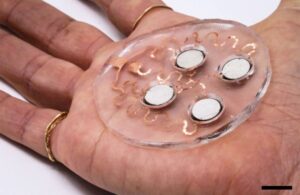
The MIT team sees the skin as an appealing route for drug delivery. It enables the drugs to travel directly to the necessary site, which offers benefits in wound care, pain relief and more. However, the tough outer layer of the skin often prevents most small molecules from passing through.
In order to address this, the researchers developed this wearable patch that applies painless ultrasonic waves to the skin. The patch creates tiny channels that drugs can pass through. Such an approach could enable the delivery of treatments for a variety of skin conditions, according to the team. They also believe they can adapt it to deliver hormones, muscle relaxants and other drugs.
“The ease-of-use and high repeatability offered by this system provides a game-changing alternative to patients and consumers suffering from skin conditions and premature skin aging,” said Canan Dagdeviren, an associate professor in MIT’s Media Lab and the senior author of the study. “Delivering drugs this way could offer less systemic toxicity and is more local, comfortable, and controllable.”
MIT research assistants Chia-Chen Yu and Aastha Shah served as the lead authors of the paper. It appears in Advanced Materials, as part of the journal’s “Rising Stars” series. Other MIT authors include Research Assistant Colin Marcus and postdoc Md Osman Goni Nayeem. Nikta Amiri, Amit Kumar Bhayadia, and Amin Karami of the University of Buffalo also authored the paper.
How the sound waves work
Looking for an alternative drug delivery method, the team wanted to explore the skin for targeted efforts.
“The main benefit with skin is that you bypass the whole gastrointestinal tract. With oral delivery, you have to deliver a much larger dose in order to account for the loss that you would have in the gastric system,” Shah said. “This is a much more targeted, focused modality of drug delivery.”
According to the team, current techniques for ultrasound exposure-led drug delivery require bulky equipment. The researchers wanted to perform this method of transdermal drug delivery with a lightweight, wearable patch. That offers more ease of use in a variety of applications, they said.
The design features a patch with several disc-shaped piezoelectric transducers. These convert electric currents into mechanical energy. Each disc is embedded in a polymeric cavity that contains the drug molecules dissolved in a liquid solution. The current applied to the piezoelectric elements generates pressure waves in the fluid, creating bubbles that burst against the skin. These bubbles produce microjets of fluid that can penetrate the skin’s outer layer.
“This works open the door to using vibrations to enhance drug delivery. There are several parameters that result in generation of different kinds of waveform patterns. Both mechanical and biological aspects of drug delivery can be improved by this new toolset,” Karami said.
How the patch is constructed
The MIT team made the patch out of PDMS. This silicone-based polymer can adhere to the skin without tape.
In their study, the researchers tested the device by delivering niacinamide, a B vitamin. This ingredient comes in many sunscreens and moisturizers.
The tests utilized pig skin and demonstrated that, when they delivered niacinamide using the ultrasound patch, the amount of drug that penetrated the skin was 26 times greater than the amount that could pass through the skin without ultrasonic assistance.
Additionally, the team compared the results from the patch to microneedling. This technique, sometimes used for transdermal drug delivery, involves puncturing the skin with miniature needles. The researchers observed the same amount of drug delivery with the patch in 30 minutes as in six hours with microneedles.
Localizing drug delivery
The MIT team says the current version of their device enables drugs to penetrate a few millimeters into the skin. This makes the approach useful for drugs that act locally within the skin. That includes niacinamide or vitamin C for treating age spots or other dark spots. It also enables the delivery of topical drugs used to heal burns.
Further modifications to increase the penetration depth could enable the delivery of drugs that need to reach the blood stream. The MIT team offered caffeine, fentanyl, or lidocaine as examples, as well as hormones like progesterone. Researchers also want to explore the possibility of implanting similar devices into the body to deliver drugs that may treat cancer or other diseases.
For now, the team aims to further optimize the wearable patch. The researchers hope to test it soon on human volunteers. They also intend to repeat the lab experiments they conducted in the study but with larger drug molecules.
“After we characterize the drug penetration profiles for much larger drugs, we would then see which candidates, like hormones or insulin, can be delivered using this technology, to provide a painless alternative for those who are currently bound to self-administer injections on a daily basis,” Shah said.

